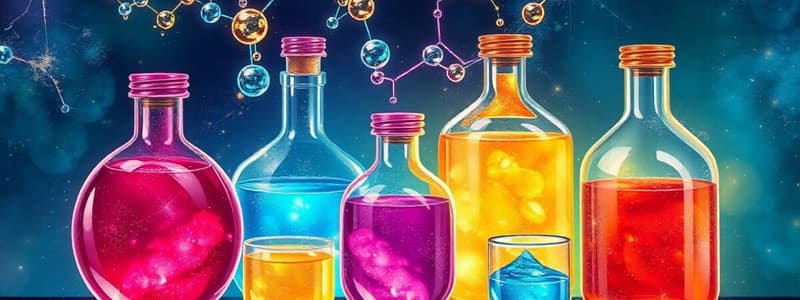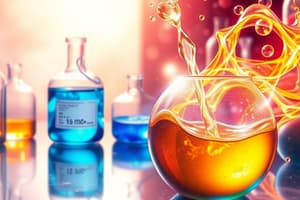Podcast
Questions and Answers
Which of the following is an example of a chemical change?
Which of the following is an example of a chemical change?
- Rusting iron (correct)
- Boiling water
- Melting ice
- Dissolving sugar in water
A covalent bond is formed through the transfer of electrons from one atom to another.
A covalent bond is formed through the transfer of electrons from one atom to another.
False (B)
According to the law of conservation of mass, in a chemical reaction, the total mass of the ________ must equal the total mass of the products.
According to the law of conservation of mass, in a chemical reaction, the total mass of the ________ must equal the total mass of the products.
reactants
Which of the following is a balanced chemical equation for the reaction between hydrogen gas and oxygen gas to form water?
Which of the following is a balanced chemical equation for the reaction between hydrogen gas and oxygen gas to form water?
Match the following reaction types with their descriptions:
Match the following reaction types with their descriptions:
Identify a clue that a chemical change has occurred.
Identify a clue that a chemical change has occurred.
What is the chemical formula for copper (II) oxide?
What is the chemical formula for copper (II) oxide?
A pH of 7 indicates a solution is acidic.
A pH of 7 indicates a solution is acidic.
What type of reaction is represented by the following equation: $2Ag + O_2 \rightarrow 2AgO$?
What type of reaction is represented by the following equation: $2Ag + O_2 \rightarrow 2AgO$?
What are the seven diatomic elements?
What are the seven diatomic elements?
Flashcards
Physical Change
Physical Change
A change in the form or appearance of a substance, but not in its chemical composition.
Chemical Change
Chemical Change
A change that involves the rearrangement of atoms and molecules to form new substances.
Ions
Ions
Ions are atoms or molecules that have gained or lost electrons, resulting in a net electric charge.
Ionic bond
Ionic bond
Signup and view all the flashcards
Covalent bond
Covalent bond
Signup and view all the flashcards
Ionic Compound
Ionic Compound
Signup and view all the flashcards
Molecular Compound
Molecular Compound
Signup and view all the flashcards
Balanced Equation
Balanced Equation
Signup and view all the flashcards
Law of Conservation of Mass
Law of Conservation of Mass
Signup and view all the flashcards
Synthesis
Synthesis
Signup and view all the flashcards
Study Notes
- Knowledge will be assessed with 20 multiple-choice questions, 5 matching questions, and 5 true/false questions.
- Thinking skills will be assessed by questions related to chemical names, formulas, experiments, classifying reactions, and balancing equations.
- Communication skills will be assessed on grammar and spelling conventions of the review.
- Application skills will be assessed via short answer questions on topics such as acids and bases, pH scale, neutralization reactions, and acid precipitation.
- The review must be turned in the day of the unit test.
Chemical Compounds (Chapter 5)
- Physical change: A change in the form or appearance of a substance, but not in its chemical composition
- Chemical change: A change that results in the formation of new chemical substances
- Ions: Atoms or molecules that have gained or lost electrons, giving them an electrical charge
- Ionic bond: A type of chemical bond formed through the electrostatic attraction between oppositely charged ions
- Covalent bond: A chemical bond that involves the sharing of electron pairs between atoms
- Ionic compound: A compound formed through ionic bonds between ions
- Molecular compound: A compound formed through covalent bonds between atoms
Chemical Names and Formulas
- Chemical names and formulas of various compounds are required.
- Examples include Potassium sulfide, Lithium iodide, Aluminum sulfide, Lead (IV) chloride, Potassium hydroxide, Lithium phosphate, Lead (II) nitrate, Carbon monoxide, Copper (II) oxide, Dinitrogen trioxide, Beryllium nitride, Calcium hydroxide, Copper (II) bromide, Ammonium chloride, Phosphorus tribromide, Tin (IV) oxide, Nitrogen (gas), Lead (II) phosphate, Magnesium chlorate, Iron (III) sulfate, Propane, CaO, N2(g), Na3N, SnI2, Mg3(PO4)2, SiO2, CaCl2, AI(HCO3)3, Fe(CIO3)3, CF4, K2SO4, P2O5, O2(g), NaHCO3, CaO, H2O, and CuSO4.
Diatomic Elements
- Recognize the 7 diatomic elements: H₂, N₂, O₂, F₂, Cl₂, Br₂, I₂
Chemical Reactions (Chapter 6)
- Word Equation: A qualitative expression of a chemical reaction using the names of the reactants and products.
- Balanced Equation: A chemical equation in which the number of atoms for each element in the reaction and the total electric charge are the same for both the reactants and the products; follows the Law of Conservation of Mass.
- Law of Conservation of Mass: Mass is neither created nor destroyed in a chemical reaction.
- Synthesis: A chemical reaction in which two or more substances combine to form a single product.
- Decomposition: A chemical reaction in which a single compound breaks down into two or more simpler substances.
- Single Displacement: A chemical reaction in which an element reacts with a compound and takes the place of another element in that compound.
- Double Displacement: A chemical reaction in which the cations and anions of two reactants switch places to form two new compounds.
- Complete Combustion of a HC: The process in which a hydrocarbon reacts with oxygen to produce carbon dioxide and water, releasing energy.
- Incomplete Combustion of a HC: Combustion in which not enough oxygen is supplied to completely burn the fuel
- Corrosion: The gradual destruction of materials (usually metals) by chemical and/or electrochemical reaction with their environment.
- Rust: A common term for iron(III) oxide, formed by the reaction of iron with oxygen in the presence of water or air moisture.
Balancing Reactions and Reaction Types
- Balance chemical reactions and identify the reaction type as synthesis (S), decomposition (D), single displacement (SD), double displacement (DD), complete combustion (CC), or incomplete combustion (IC).
- Examples of reactions for balancing include Ag + O₂ → Ag₂O, KCIO₃ → KCI + O₂, Na + H₂O → NaOH + H₂, H₂ + O₂ → H₂O, CO₂ + H₂O → C₆H₁₂O₆ + O₂, AgCl + Mg(NO₃)₂ → AgNO₃ + MgCl₂, KBr + Al₂(SO₄)₃ → AlBr₃ + K₂SO₄, Fe(OH)₃ + NaCl → FeCl₃ + NaOH, CH₄ + O₂ → CO₂ + H₂O, and C₃H₈ + O₂ → CO₂ + H₂O.
- Word equations of reactions (e.g., calcium + oxygen → calcium oxide) are also to be converted to balanced equations.
Acids & Bases (Chapter 7)
- Acid: A molecule or ion capable of donating a proton or forming a covalent bond with an electron pair.
- Base: A molecule or ion able to accept a hydrogen ion from an acid.
- Acid-base indicator: A substance which changes color depending on the pH of the solution it is in.
- pH: A measure of the acidity or basicity of an aqueous solution.
- pH Scale: A logarithmic scale used to specify the acidity or basicity of an aqueous solution.
- Neutral: A solution with a pH of 7, where the concentration of hydrogen ions (H+) is equal to the concentration of hydroxide ions (OH-).
- Neutralization reaction: A chemical reaction in which an acid and a base react quantitatively with each other.
- Acid precipitation: Rain, snow, or other precipitation with a pH lower than 5.6, caused by atmospheric pollution.
- Acid Leaching: The process by which acids remove metallic ions from the soil.
Studying That Suits You
Use AI to generate personalized quizzes and flashcards to suit your learning preferences.




